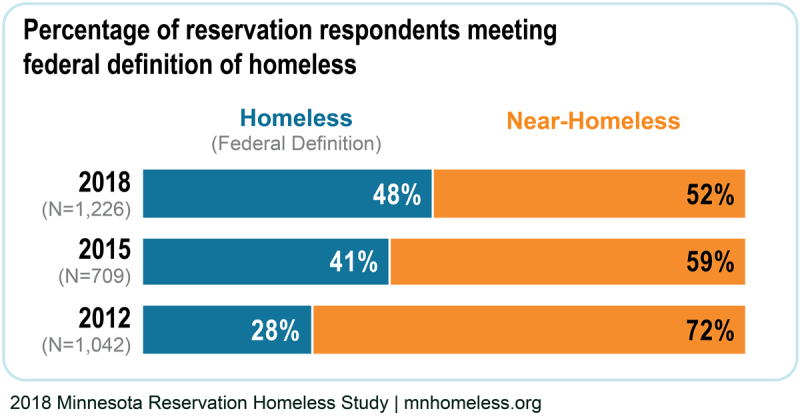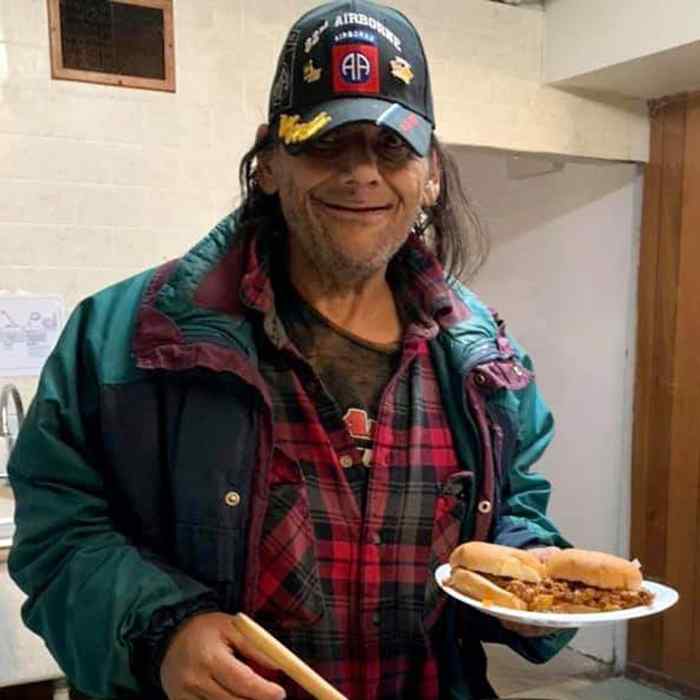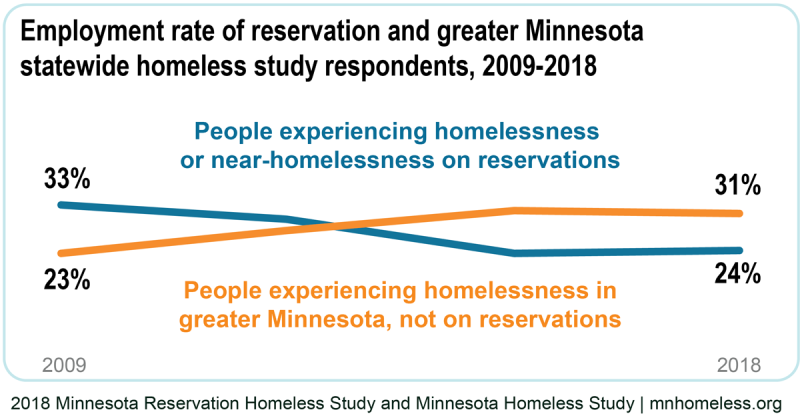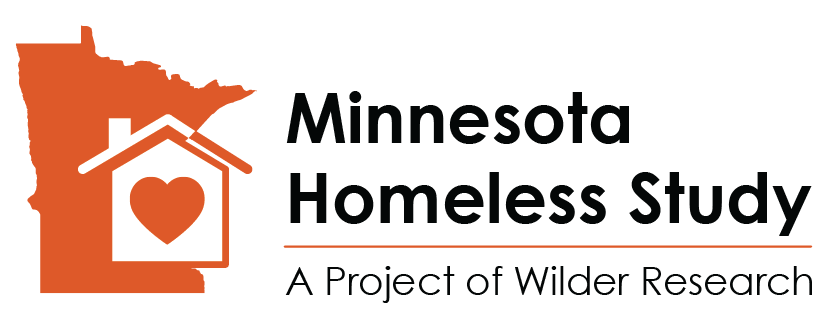Homelessness on American Indian Reservations
Key findings from the 2018 Minnesota Reservation Homeless Study
The Reservation Homeless Study is conducted every three years in partnership with six American Indian reservations in Minnesota: Bois Forte Band of Chippewa, Fond du Lac Band of Lake Superior Chippewa, Leech Lake Band of Ojibwe, Mille Lacs Band of Ojibwe, Red Lake Nation, and White Earth Nation.
The study runs alongside the Minnesota Homeless Study.
Results from the 2023 Reservation Homeless Study will be released in 2025.
Wilder Research worked with participating tribes to collect information in October 2018 through 1,226 interviews with people experiencing homelessness or near-homelessness. On the day they were surveyed, these respondents were accompanied by 1,089 others – including significant others, friends, and children.
In total, 2,315 people were counted as part of the study.
Key Findings from the 2018 Reservation Homeless Study
The percentage of study participants meeting the federal definition of homelessness continues to climb.
Compared to previous years, a greater proportion of respondents were experiencing literal homelessness. Some of this growth can be attributed to increased shelter and transitional housing infrastructure on reservations as well as significant outreach efforts.

Read reports from the 2018 Reservation Homeless Study

Homelessness on Minnesota American Indian Reservations: Findings from the 2018 Minnesota Reservation Homeless Study
Read the report »2018 Minnesota Reservation Homeless Study Key Findings
This brief summarizes findings from the 2018 study conducted in partnership with six of Minnesota’s American Indian reservations. Read the report »Children, youth, and elders make up half of the homeless and near-homeless population on participating reservations.

Many families experience homelessness or near-homelessness on reservations – including those with small children. More than 1 in 4 respondents were parents accompanied by their children, and over half (52%) of all children with these parents were age 6 or younger.
- Most respondents are experiencing chronic, long-term homelessness. 77% of people interviewed on reservations met the Minnesota definition of long-term homelessness: those who have been without a permanent residence for at least one year, or four or more times during the last three years.
- 2 of 3 respondents (64%) were living on a reservation before becoming homeless or near-homeless. In addition, most study respondents were enrolled tribal members (86%) and were living with their affiliated tribe at the time of the interview (76%).
Employment rates are lower for adults experiencing homelessness or near-homelessness on reservations.
During the previous three studies, employment rates among reservation study participants fell, while employment rates among adults experiencing homelessness in greater Minnesota increased. This suggests that those experiencing homelessness on reservations have not benefited as much from economic recovery.

Doubling up and near-homelessness on American Indian reservations are common.
70% of respondents were doubled up – that is, staying with a family member or someone they knew rather than living outside or in places not intended for human habitation. Doubling up has historically been the most common form of homelessness on reservations. Anecdotally, we know this is due to a strong cultural tradition of not letting one’s relatives go without a place to stay when you have a home.
Doubling up is not a common preference among the American Indians surveyed. Nearly all respondents (99%) would live in their own housing – not doubled up with family or friends – if they could find or afford it.
Many doubled-up respondents face considerable difficulty securing housing. During the month before the survey, 34% of doubled-up respondents (both homeless and near-homeless) had spent at least one night in a location not intended for housing; 11% had done the same for more than a week. Only 5% of doubled-up respondents reported spending time in a shelter or transitional housing program in the month before the survey.
Doubled-up arrangements are often unstable.
- 89% of doubled-up respondents lived in 2+ places during the previous year, and 49% had lived in 4+ places.
- 57% were confident they could stay where they were for another month without being asked to leave, while 17% were unsure and 26% felt they could not remain where they were currently staying for another month.
Among those who were doubled up, overcrowding and substandard conditions are concerns.
- 74% of doubled-up respondents live in overcrowded spaces (where the number of residents is greater than the number of rooms in a home); 51% of doubled-up respondents were living in severely overcrowded spaces (more than 1.5 residents per room).
- 22% of those doubled up were living in substandard housing, defined as housing that lacks a flush toilet, electricity, central heat, a kitchen sink, or hot and cold running water.
Chronic physical health conditions and mental health challenges are common among reservation respondents.
- Nearly half of respondents reported a serious chronic physical health condition (47%) or mental health condition (44%).
- Co-occurrence of a variety of health issues is common: 67% of reservation respondents had at least one serious health condition (chronic physical health condition, serious mental illness, or substance abuse disorder); 38% of respondents reported two of the conditions; 11% reported all three.
- Adverse childhood experiences (ACEs) are prevalent among reservation respondents. 71% of reservation respondents had experienced at least one ACE; 42% had experienced three or more ACEs.
- 1 in 4 reservation respondents (28%) face physical, mental, or other health challenges that limit their ability to work or perform daily activities.
Access to services and public benefits presents challenges.
Housing waiting lists are very long on reservations. On average, participants in the reservation study who said they were on a housing waiting list had been waiting 14 months, compared with 9 months for people experiencing homelessness in greater Minnesota.
Reservation respondents exiting jail or prison need more supports and services to find housing. 74% of respondents who were recently incarcerated were homeless upon entering a correctional facility, 34% did not have a stable place to live when they exited a facility.
Reservation respondents generally reported low utilization of public benefits and services, with 37% receiving public assistance in the form of cash benefits in the month prior to the survey. These findings indicate that people experiencing homelessness on reservations may need more support to connect to public services and benefits for which they may be eligible.
American Indians in the Statewide Minnesota Homeless Study
The reservation study is conducted every three years in conjunction with Wilder Research’s statewide study of homelessness. In contrast to the reservation study, the statewide study does not include those who are doubled up longer term (it only includes those who are literally homeless according to the HUD definition).
- In the statewide study, 18% of adults identified themselves as American Indian alone or American Indian as part of a multiple-race heritage. 16% of people interviewed in the Twin Cities metro area and 23% of people interviewed in greater Minnesota identified as American Indian.
- As on reservations, long-term homelessness was a challenge for American Indian respondents in the statewide survey: 74% of American Indians off reservations had been homeless for at least one year or four or more times during the last three years, compared to 63% of people experiencing homelessness who did not identify as American Indian.
Tribal Housing Partners
Bois Forte Band of Chippewa
Pamela Hughes, Chemical Dependency/New Moon Program Director
218-753-2347, phughes@boisforte-nsn.gov
Fond du Lac Band of Lake Superior Chippewa
Tawny Smith-Savage, Social Services Department Coordinator
218-409-5770, TawnySmith-Savage@fdlrez.com
Leech Lake Band of Ojibwe
Sharon Northbird, Homeless Programs, Leech Lake Housing Authority
218-335-8267, Northbirds@midconetwork.com
Mille Lacs Band of Ojibwe
Tammy Moreland, Wraparound Coordinator, Department of Community Support Services
320-292-1942, Tammy.Moreland@HHS.millelacsband-nsn.gov
Red Lake Nation
Jordan May, Interim Executive Director, Red Lake Homeless Shelter
218-679-3228, Jordanmay@Redlakenation.org
White Earth Nation
Kristi Dawes, Homeless Housing Coordinator
218-935-5554 x3263, kristi.dawes@whiteearth-nsn.gov
One of the key groups addressing these challenges is the Minnesota Tribal Collaborative to Prevent and End Homelessness, which consists of members from five of the tribes participating in this study: Bois Forte, Leech Lake, Mille Lacs, Red Lake, and White Earth. Collaborative members meet regularly to share ideas, learn about new resources, apply for funding, and advocate for state-level changes to better address homelessness in their communities.
